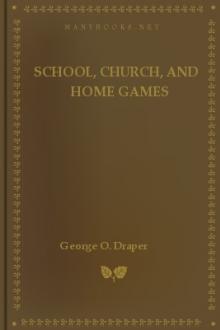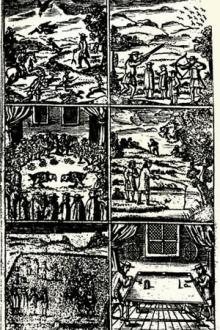School, Church, and Home Games, George Orrin Draper [best classic literature .TXT] 📗

- Author: George Orrin Draper
- Performer: -
Book online «School, Church, and Home Games, George Orrin Draper [best classic literature .TXT] 📗». Author George Orrin Draper
Balloon Race
An inflated rubber balloon and a palm leaf fan must be provided for each team. Four players constitute a team. A balloon is placed on the starting line before each team and a fan handed to the first competitor. At the signal to go the balloon is blown forward by means of the fan across the distance line, blown back by the second player, forward again by the third and back across the finish line by the fourth. The team first succeeding wins the honors.
Lobster Race
Each competitor gets down on the starting line on all fours and at the signal to go travels backward on all fours to the distance line and returns.
Prune Tug of War
Prunes are tied in the middle of a piece of string, three yards long. Opponents are placed opposite each other, each with an end of the string in his mouth. At the signal to go they are to chew the string towards the prune. The one first reaching the prune may eat his prize.
Whistle Race
Contestants take a deep breath and whistle. The one who can whistle longest on one breath, wins.
Cracker Relay
Six players to a team. The players on each team sit in a row. Four crackers are given to each player. The one on the rear of each team starts the race by standing up and eating the crackers. When he has eaten all four crackers and is able to whistle, his whistle is the signal for the man next in front of him to stand up and eat his crackers, while the first man resumes his seat. So each in turn eats four crackers. When the last, or front man on each team is able to whistle after devouring his crackers, the race ends.
Blindfold Obstacles
Obstacles, such as vases of flowers, china ware, chairs, etc., are placed in four or more long rows. Each contestant is given a row and is requested to try distances before being blindfolded. They then are all blindfolded, placed at the starting point, and told to race down through the line of obstacles without touching anything. In the meantime the objects have been removed.
Candle Roll Over
Four players are chosen for each team. Two are lined up in front of the starting line and two opposite on the distance line. One of the players on the starting line is given a lighted candle. A mat is placed half way between the starting and the distance lines. At the signal to start the player holding the candle advances to the mat, executes a forward roll on the mat, holding the candle in his hand. Should the candle go out during the roll, he must go back to the starting line and start over after lighting the candle. When he has succeeded in making the roll without extinguishing the candle, he proceeds to the distance line where he passes on the lighted candle to the second member of his team. This one returns to the starting line, rolling on the mat as did his predecessor. Should the candle in his hand become extinguished, he must go back to the line from which he started, light his candle and start over. This continues until all four men have covered the required distance, each having rolled over without having extinguished the candle.
Boat Race
Two players constitute a team in this race. One of the players on each team sits upon the floor. His knees are raised so as to allow his feet to rest flat upon the floor. The other member of the team then sits upon his teammate's feet, facing him, and places his feet and legs in a similar position to that of his teammate, so that each may sit upon the other's feet. They then place their hands upon each other's shoulders.
To race in this position, Number 1, the player whose back is in the direction to be traveled, leans well forward so that his weight is well on his own feet. This makes it possible for his teammate, Number 2, to slide his feet forward along the floor, carrying Number 1 backward upon them. Number 2 then leans forward so that his weight is well on his own feet, which allows Number 1 to draw his feet towards him and Number 2 slides forward with them. By swaying backward and forward in this way, the two members of the team, by alternating the sliding of their feet, progress across the floor to the distance line. Upon reaching the same, they reverse their direction without turning around. The race ends when they have crossed the starting line.
Necktie Race
Two players constitute a team. Each team may stand opposite each other at different ends of the room. At the signal to go Number 1 runs forward to Number 2, who must wear a four-in-hand necktie. Number 1 unties Number 2's necktie, takes it off his neck and reties it in a four-in-hand knot. Number 1 then runs back to his former position with Number 2 following him. When behind the starting line Number 2 starts to untie Number 1's necktie, takes it from his neck, replaces it and ties it in a four-in-hand knot. When he has accomplished this, he races back to his original position. The first team accomplishing this, wins the game.
Push Cross Line
Three parallel lines are marked upon the ground about six feet apart. The group is divided into two teams. Each team lines up behind one of the outside lines, facing the opponents. At the signal to start, both groups rush forward and endeavor to push their opponents back over their own base line. Should they succeed in pushing the opponent so that both of his feet are behind the base line, that opponent is out of the game and retires to a position behind his own base line. At the end of thirty seconds the team having pushed the greatest number of opponents back across their own base line, wins.
Fortress
This game is similar to the preceding game. Three parallel lines are made around a hollow square not less than 25 to 40 feet in dimensions. This square is known as the fortress. A small space is marked off in the centre of the fortress for a prison. Two captains are selected. These two choose the members of their own teams, in turn. One team is known as the defenders, the other as the attackers. The defending party takes a position within the fortress and the attacking party is scattered around the outside of the fort. Both are under the command of their captains.
The attacking party may charge the fort as a group or may use any tactics the captain may decide upon. He may feign an attack on one side to draw the defenders' attention, while his principal attack may be directed towards another point of the fortress. The methods of engagement are as follows:
Opponents endeavor to push, pull, or carry each other across the guard line. The defending players seek to force as many of the attacking players in across the inside line as possible. Succeeding in this, such players as have been drawn beyond the inside line are prisoners and must take their place in the prison. The attacking party seeks to force as many of the defenders beyond the outside line as possible. Succeeding in this, all those so forced are placed in a small area, which constitutes the prison of the attacking army. The captain should seek to direct the strong against the strong as much as possible in personal combat. The captains may exchange prisoners if they so desire.
The battle is won by either party making prisoners of all the opponents, or it may be won by the besiegers, if one of their number enters unattacked the prison within the fortress. Should the player accomplish this, he shouts, "Hole's won," whereupon the defenders must yield the fortress and the two armies change places, the defenders becoming the attackers, and vice versa. If an old fence is used for one side of the fortress, the other guard line should be drawn five feet inside of the fence line.
The attacking captain may withdraw his forces at any time for rest or consultation. Either captain may use a flag of truce for similar purposes. Under such conditions they arrange for an exchange of prisoners, etc.
Forcing the City Gates
This is an old Chinese game. Two captains are selected, who in turn choose all the other players. The two teams are first formed in two lines, facing each other and about ten feet apart, with the players grasping hands. Each line represents a city gate. The captain should arrange the players so that the weakest may be between two strong players.
The play begins when the captain of one of the teams sends forward one of his men. This man can make three attempts to break through the opponent's city gate. He can do this, either by breaking the grasp of two of the players or by dodging underneath their arms or between their legs. Should he succeed in doing this, he takes back to reinforce his own line the two players who are responsible for his getting through. Should he fail, he enlists his efforts with those of his opponents by joining their line. The game is won when one team has succeeded in taking over all of the opponents.
Hare and Hound
This is an old game which is always popular. Two or three players are designated as hares. Each is given a large bag filled with paper torn into small bits. The hares are allowed a few minutes' start ahead of the rest of the players, who are known as hounds. The hounds follow the hares by means of the torn bits of paper scattered on the ground, in an effort to overtake them.
When the hares have used up all of their paper they hide their three bags near the end of the trail and race back from that point to the place from which the run started. When the hounds have discovered the bags, they also race back to the starting place. The game is won by the first player reaching said place.
Human Targets
An old flour or salt bag stuffed with straw or cloth may be used for this game. One player is selected to be the target. The others endeavor to hit the target by throwing the bag. The target may run or dodge in any way he desires, but the one who holds the bag cannot advance towards him in making his throw. If he is not near enough to hit the target, he can throw the bag to some other player who is nearer. When the target has been hit, the leader selects some one else to act as target.
Sling the Sack
Either a good sized sack well stuffed with rags or straw, or a small cloth sack filled with sand, may be used for this game. The game can be played on a level stretch of road or in a good sized field. The group is divided into two equal teams. A starting line is marked near the center of the playing space. A player from each team takes a position behind this starting line and in turn, with his left foot on the starting line and with his shoulders at right angles to it, slings the sack with his right arm straight at the elbow, over his head as far as possible. A left-handed player may reverse this position. The spot where the sack





Comments (0)